You’ve downloaded the game, you’ve honed your skill set, and you’re ready. Ready to venture into Runeterra like you’ve never ventured before. But wait… Look at ALL these cards! Legends of Runeterra tackles the wonderful realm of card games in new and exciting ways, but we want to ensure you’re as prepared as possible for the furious battles to come. That means it’s time to talk about cards.
There are four main card types to be aware of in LoR:
-
Followers: These units can be summoned and hang out in the back row before they’re played. They can deal and take damage, attack, and block. Think of these as your troops, stalwart and ready to plunge into battle.
-
Champions: If the units are your troops, then champions are a bit like commanders. Sitting in the back row with your other units, these cards each have special conditions that allow them to level up! Try exploring the regions of Runeterra to learn more about the champions.
-
Spells: You’re a wizard, player! Or, at least, you can act like one by playing these cards. Spells can be used at various times depending on the spell speed (we’ll get into that later), and they can produce game-changing effects!
- Landmarks: Once summoned, landmarks take up a spot on the back row. They can't attack or block, nor do they have health or power. Instead, they offer unique effects that can either help you, or harm your opponent.
While champions are often powerful fighters, they are not always stronger than another unit. Use both to master the game and plan out your strategy.
Now that you know the basics, let’s dive a little deeper.
Followers
Let’s take a look below for a breakdown of the Scarmother Vrynna card:
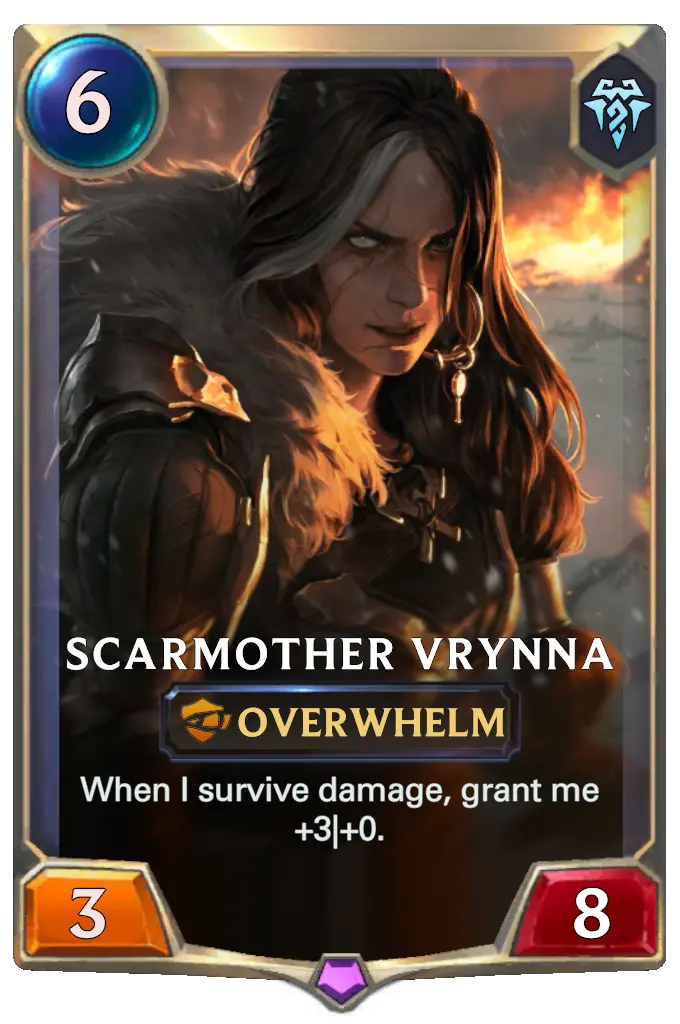
In the top left hand corner is the mana cost. If you want to play Vrynna, it’s going to cost you 6 mana. This usually means you can play her right around turn six (but there may be ways to summon powerful cards like the Scarmother early).
The name of the card is in the middle, so you (and your enemies) know exactly who you’re dealing with.
Underneath the name of the card will be any relevant keywords. Here, Overwhelm means that any excess damage dealt by Scarmother Vrynna to a unit goes to the enemy Nexus!
After the card name and keywords will be any other special abilities your unit might possess. In our example, Scarmother Vrynna lives up to her name, gaining power every time she survives damage!
See that Freljord symbol in the top right corner? That just lets you know which region of Runeterra the card hails from!
Last, but certainly not least, are your unit’s power and health, respectively. Scarmother Vrynna may not hit hard to start, but let her defend on the battlefield and watch her power rage like the winds of the Freljord.
Keep an eye out for fun combos between cards that trigger each other's abilities, and play your way to victory!
Champions
Champions are a special type of unit that can level up, gaining stats and better abilities.
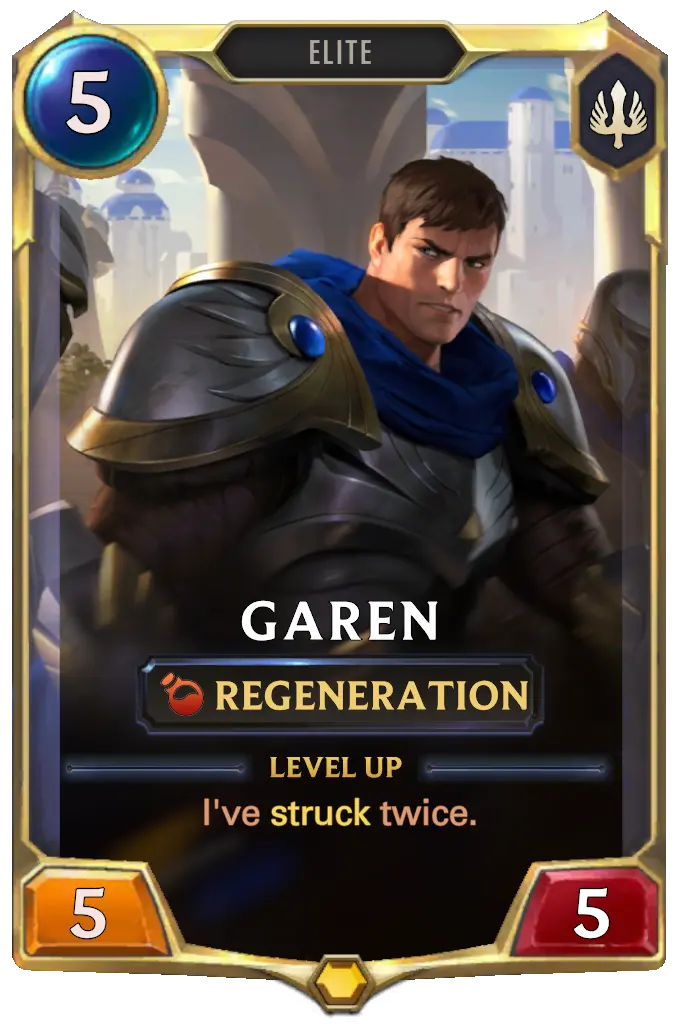
Level Up Conditions
This is what makes champions so powerful! Beyond just stellar stats, they have the unique capability to Level Up. Each champion has a unique level-up condition, located on the center of the card under the champion’s name (hover or click the card to see it!). When the conditions are met, the champion will level up and gain new abilities.
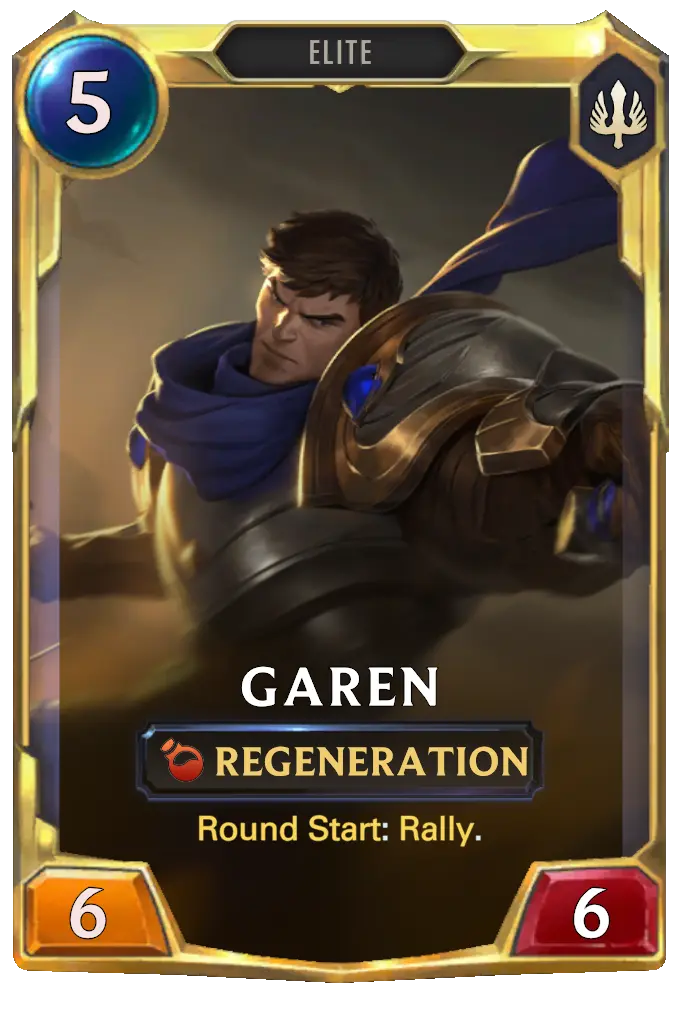
Check out Garen above. He's leveled up, boosting his health and power. Even if your champion dies after leveling up, when you draw and summon a new copy, the new copy will be leveled up, too! Enemies beware!
Champion Spell
When a champion is on your board, if you have another copy of the champion in your hand, it will transform into a spell instead! This means that, barring any sneaky tactics, you can’t have two of the same champion on your board at the same time. In addition to its usual effect, it also returns a copy of that champion to your deck. You can see the champion spell by entering expanded view by tapping the magnifying glass.
Spells
There are three different types of spells that correspond to when they can be played: burst, fast, and slow.
Burst Spells
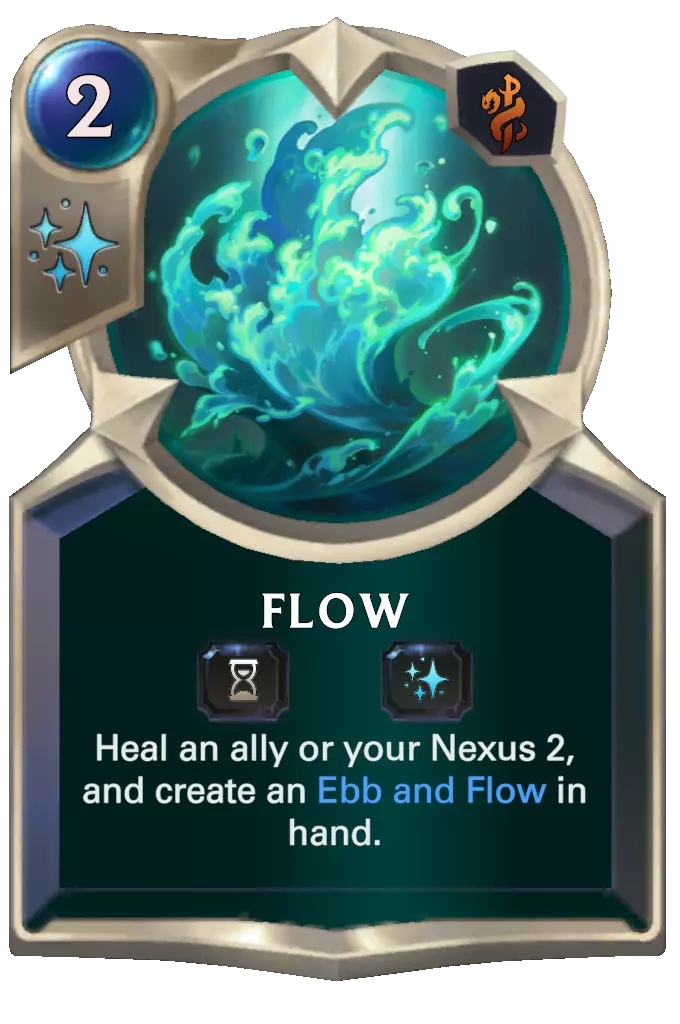
Burst spells can be played any time and cannot be countered or responded to by any enemy spells! This means you can play as many as you’d like (until you run out of mana) as long as it’s your action. They're indicated by a sparkle icon on the left side of the spell and will say BURST in the expanded view.
Fast Spells

Fast spells can be played during combat or in response to another fast or slow spell. Once both players have passed without adding an additional spell to the sequence, they resolve order of left to right.
Playing fast spells will give your opponent the opportunity to respond, so be mindful of the times you use them (and keep your enemy's remaining mana in mind). Fast spells are indicated by a winged-shoe icon on the left side of the spell and say FAST in the expanded view.
Slow Spells
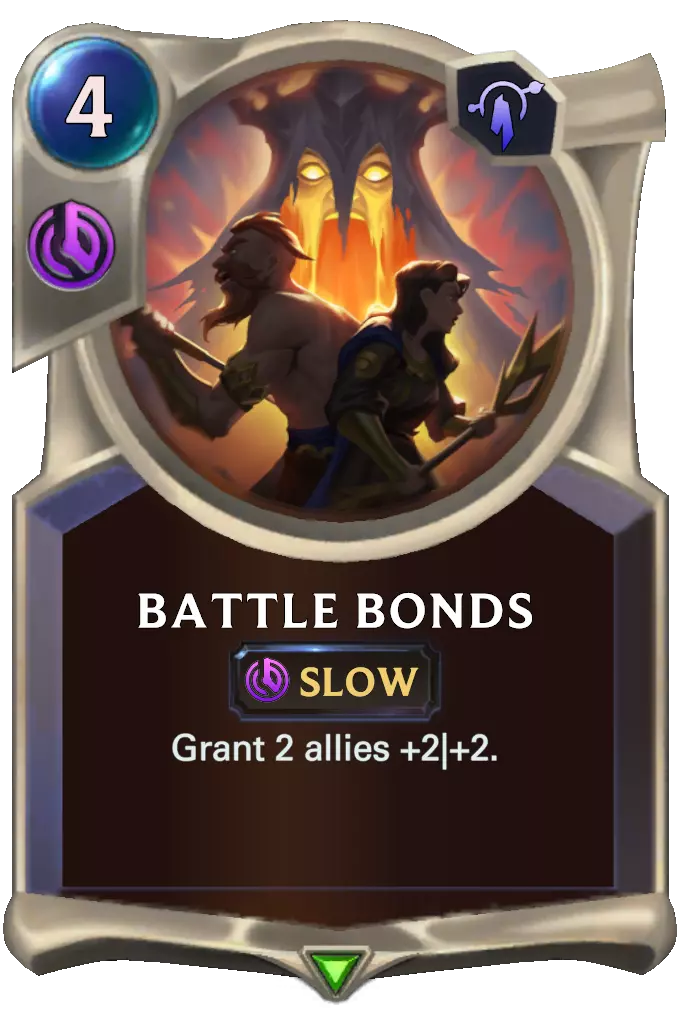
Slow spells are just like they sound...slow! But what they lack in speed, they make up for in power. These can only be played when it’s your action and there’s no combat or spell sequence in progress. They can be countered or responded to with fast or burst spells, so keep your enemy's remaining mana in mind when playing particular spells!
Slow spells are indicated by a purple clock on the left side of the spell and say SLOW in the expanded view.
Landmarks
While on the board, landmarks provide unique abilities.
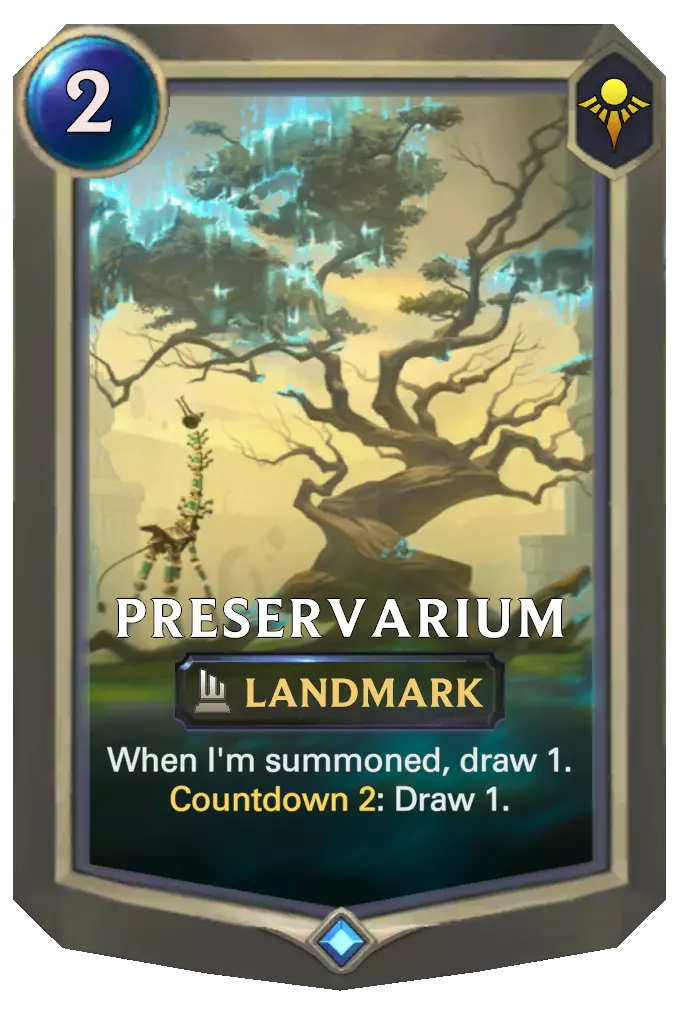
Landmarks can't take damage or be killed (they're just places, after all!). To get rid of a landmark, you either have to replace it when your bench is full or it has to otherwise be destroyed via a spell or effect that destroys landmarks, or through the landmark's countdown.
Now, you might be wondering how this countdown thing works. Well, let me tell ya! A landmark's count goes down at the start of each round. Once the countdown reaches 0, the listed effect activates and the landmark is destroyed. Check out the Preservarium card above. It says Countdown 2: Draw 1. So 2 rounds after you play it, the countdown effect will activate (draw 1 card) and the Preservarium will be destroyed.
Not all landmarks have a countdown, however. Check out The Grand Plaza:
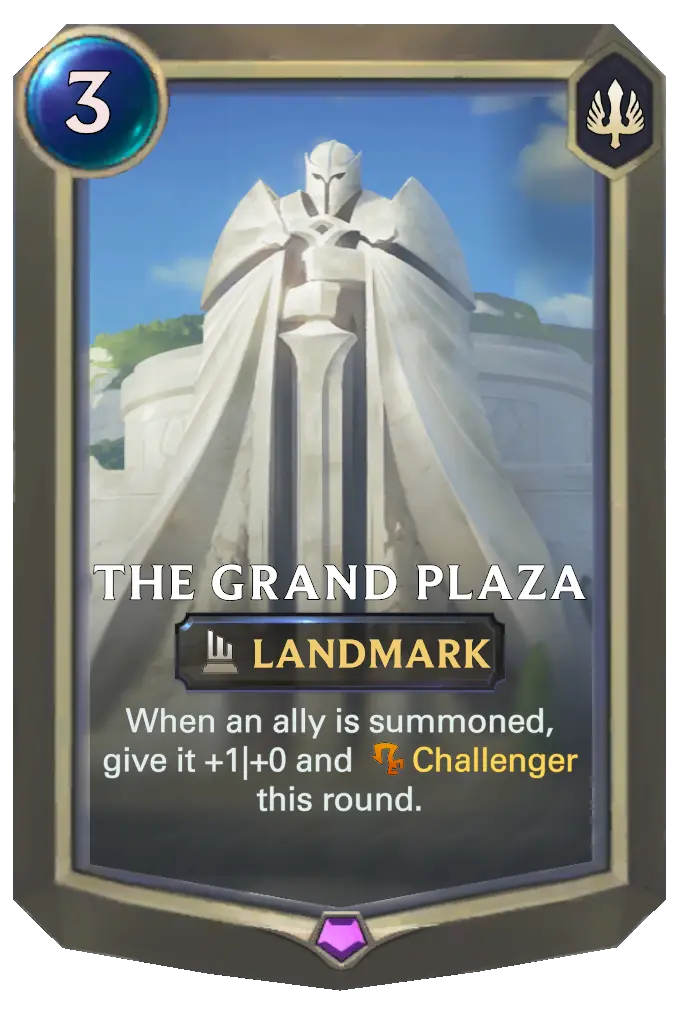
Since this landmark doesn't have a countdown, it stays on the board until either you or your opponent actively destroys it.
